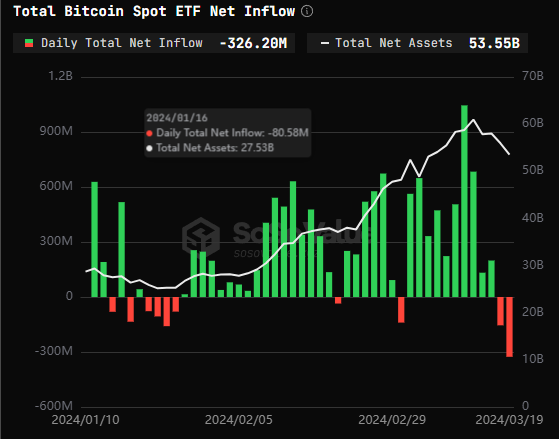Bitcoin (BTC) recently achieved a significant milestone by reaching an all-time high (ATH) of $73,700 on March 14th. This surge was primarily attributed to the booming Bitcoin ETF market, which substantially impacted the cryptocurrency’s price.
However, following this new ATH, BTC has experienced a significant price correction, hitting a low of $60,900 on Tuesday, March 19th. The main factors contributing to this downturn are the increased selling activity of Grayscale’s Bitcoin Trust ETF (GBTC) and a decline in demand for the new investment vehicles approved by the US Securities and Exchange Commission (SEC) on January 10th.
Days Of Negative Bitcoin ETF Flows
James Butterfill, the head of research at CoinShares, shed light on the situation, stating that net Bitcoin ETF flows have been negative for two consecutive days. This negative trend results from heightened outflows from Grayscale and reduced demand for new ETFs in the United States, Butterfill remarked.
On March 19 alone, there was a net outflow of $326 million from Bitcoin spot ETFs, with the outflows continuing for two days. Grayscale’s GBTC witnessed a single-day net outflow of $443 million.

The only Bitcoin ETF to see net inflows on the day was BlackRock’s IBIT ETF, with a modest single-day net inflow of $75.23 million.
It is worth noting that despite the lack of demand and record outflows in recent days, the total assets under management of the ten Bitcoin ETF issuers remain at a whopping $53.5 billion.
The Liquidity Challenge
Economist and global strategist Peter Schiff has raised concerns regarding the limited liquidity of Bitcoin held in an ETF. In a recent social media post, Schiff highlighted that owning Bitcoin through an ETF restricts liquidity to US market hours.
This means that if a market crash occurs overnight, investors cannot sell until the US market opens in the morning. Schiff expressed frustration at the inability to take action when needed.
A user responded to Schiff’s statement, interpreting it as an indication that holding Bitcoin ETFs would leave investors on the sidelines during a market crash, missing out on the opportunity to buy the dip.
The user argued that those holding the actual Bitcoin can take advantage of such situations while ETF investors are disadvantaged. Schiff concurred with the user’s perspective, emphasizing that owning Bitcoin directly provides better options than relying on a third party to store it and facing limited liquidity.
Schiff’s preference for owning Bitcoin aligns with the principle of self-custody and control over one’s assets. By holding the actual cryptocurrency, investors can execute transactions at any time, regardless of market hours or the involvement of intermediaries.
Currently, the price of BTC stands at $63,800, reflecting a 3% increase over the past 24 hours. The forthcoming price movements of the dominant cryptocurrency and its correlation with the ETF market, which has emerged as a significant factor impacting BTC’s price volatility, are eagerly anticipated. It remains to be seen how these factors will shape the future trajectory of the cryptocurrency market.
Featured image from Shutterstock, chart from TradingView.com





